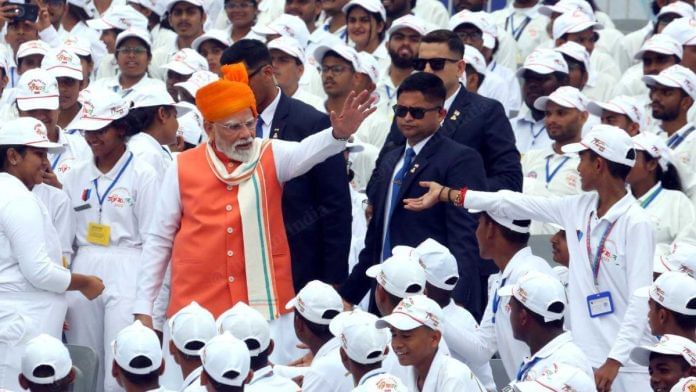Prime Minister Narendra Modi’s 12th consecutive address to the nation from the ramparts of the Red Fort was peppered with references to Swadeshi, self-reliance and self-respect. In many ways, it resonated with the mood of 1947 more than the zeitgeist of 1991. While there is a wide gulf in the beliefs of Nehru—the only PM to deliver more successive speeches on Independence Day—there is a similarity in the commitment to self-reliance. Nehru’s call for self-reliance failed to launch. Can Modi’s? It depends on how the vision is translated into reality.
Self-reliance is a double-edged sword. As is the oft-repeated fact of India being a large domestic market. In fact, the latter usually reinforces the former. India can be self-reliant because it’s large. It doesn’t need the world because it has its own market. There are two things to be cautious about in such a narrative.
One, India is a large market, but it is a fraction of the size of the global market. The global trade in just merchandise is around $24 trillion, six times more than India’s manufacturing, services and agriculture combined. It limits both ambition and possibilities to consider only the domestic market.
Second, there is an element of philosophical protectionism in eschewing global markets. That is what doomed Nehru’s vision. Producing goods in India of poor quality and high costs is one way of achieving self-reliance, but it is self-defeating for prosperity.
Since 1947, many nations which were worse off than India have surpassed it by some distance. None of them, whether Korea, China or Vietnam, did self-reliance. They aimed to capture global markets, starting with low technology sectors, gradually moving up the value chain. Of the three, China could have also played up its large domestic market card. But it realised that in a mostly low-income country, a large market is a chimaera.
Also read: Have we reached a stage where we can say we’re proud of India? The data says so
The way to self-reliance
India’s challenge in 2025 is acute. It is attempting to do what no country has done before. It is still striving to build a competitive manufacturing sector, particularly in low-technology, mass-produced goods like textiles, footwear, sports goods, and toys. It is still in catch-up mode. Given today’s technological advancements, it has become imperative to build a capability in cutting-edge areas like Artificial Intelligence, advanced semiconductors, modern weaponry, and even electric vehicles. It needs to leapfrog, given how far behind it is, not just over the West but also China and competitors in the East. It has to do all of this in a world which is more reluctant about openness, trade and sharing technology than at any time in the last forty years.
The global mood may be insular, but for India, self-reliance has to be paired with global ambition. That is the only way to achieve scale, quality and a cutting edge. Even if world trade doesn’t grow by much, India must corner a greater share of the pie.
The government also needs to be aware of what needs to be done. For mass manufacturing, the solution lies in policy reform. Without the liberalisation of land and labour markets, rationalisation of power tariffs, lowering of trade barriers, faster clearances, this segment will simply not pick up. Essentially, the government needs to get out of the way. This remains the most crucial sector for creating good-quality jobs for the maximum number of people.
In the high-technology sectors, a different approach is required. There is room for industrial policy, but of an American kind, not an East Asian kind. The government needs to commit its financial resources and use the might of its procurement capacity. To its credit, it has adopted the right approach in semiconductors by spending almost $10 billion in subsidies. However, it largely supports testing and packaging units at the low end of the value chain, as it did in assembly in mobile phones. The only chipmaker among the projects is the Tata enterprise in Dholera. There needs to be a great degree of risk-taking on the part of the government if India is to leapfrog. In semiconductors, it will otherwise take too long to even catch up, forget getting ahead.
In its defence, the government has invested in the right foreign platforms but needs to enable a transition to R&D by Indian companies and develop better indigenous platforms on top of those international platforms.
The good news is that, unlike Nehru, Modi has chosen to put the private sector in front. He believes in India’s entrepreneurship. He is open to using industrial policy without intrusive government control, not the case in the 1950s and 1960s. The PLI is an excellent example. He is also choosing to be more selective about the priority sectors for self-reliance. In his speech, he spoke about energy, critical minerals, electronics, defence and fertilisers. That is a more strategic approach than Nehru’s across-the-board one. He has spoken about self-reliance in terms of capability, which is also refreshing rather than just the large domestic market argument.
Now, it’s over to implementation. As long as we have eyes on the global market and the right role of government, Self-Reliance 2.0 may just work out well.
Dhiraj Nayyar is Chief Economist at Vedanta. His X handle is @nayyardhiraj. Views are personal.
(Edited by Theres Sudeep)







How could it not be so. Eighty years have passed, the world has changed, so has India. A better framing of the question would be, why is India so diffident towards full throated economic reforms. Maharashtra itself could equal Vietnam. There should be no export diffidence. Name one developing country which has prospered by looking inwards.
One is a third-rate socialist, the other one is a fourth-rate socialist.